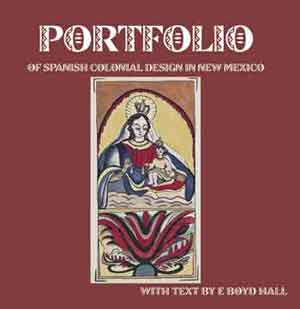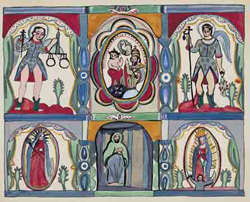by E Boyd Hall
ISBN 1-890689-21-1; $39.95
2001, 128 pp; 47 color and 15 b/w illustrations

Description
The WPA Portfolio was commissioned in 1937 and many area artists hand-colored the original prints made from plates supervised by E Boyd. The booklet that accompanies the 50 color plates was also written by Boyd, who later headed the Museum of International Folk Art. 200 numbered copies of the Portfolio were designated for use by the Federal Government but it is said when the Feds saw the Portfolio they didn't understand the New Mexican santos, altar screens, tinwork, straw crosses, hide painting, furniture depicted in the paintings and ordered the Portfolios destroyed. But as many as thirty to forty copies remain today in libraries and private collections. The last remaining artist to work on the project is Eliseo Rodríguez, an award-winning Spanish Market artist from Santa Fe. According to Rodríguez, "I painted hundreds of the Laguna Altar Screen print, over and over but I never saw the entire Portfolio." He remembers painting sessions with E Boyd at his kitchen table while the project was in progress. According to LPD Press Senior Partner, Paul Rhetts, "This is a chance for people to own a part of New Mexico's history. Many great artists like Eliseo, Louie Ewing, Gustave Baumann, Helmut Naumer, John Gaw Meem, Caddy Wells, and Paul Horgan were involved in the production the Portfolio and all of the fifty plates were made using existing Spanish Colonial art of New Mexico as the subject matter. The art is extraordinary."
Reviews
This book-within-a-book offers a unique look at New Mexico arts. The current publication coincided with the 75th anniversary of the Spanish Colonial Arts Society and the 50th anniversary of Spanish Market. The original portfolio, which is replicated in this edition, came into being in the 1930's, when the Works Progress Administration created the Federal Art Project employing thousands of artists around the country. They eventually created 2,566 murals, 100,000 paintings, 17,700 sculptures and 300,000 fine prints. The intention of the Portfolio was to document a wide variety of traditional Hispanic New Mexican arts and crafts from the Colonial Period. Eventually these would be included in the FAP's Index of American Design. Master plates were done by hand in watercolor from which wood blocks were cut, Prints were made from these and then again hand-colored by 44 artists. Bultos, retablos, santos, furniture, fabric arts and more are represented here. Very few copies of the original linen-cased edition were printed; even fewer survived. Awalt and Rhetts tell the fascinating tale of chasing down enough copies of the original portfolio using the Internet to faithfully reproduce this facsimile edition. For art lovers, historians, bibliophiles and lovers of local color, these beautifully reproduced color and black and white plates printed on high quality stock ensure the survival of this valuable edition for many years to come. -- Marilyn Abraham, Southwest Book Views, Winter 2002.
The history of this book is almost as fascinating as the book itself. The WPA commissioned the Portfolio in 1937 and many area artists hand-colored the prints, which came with a booklet by E. Boyd. There were 200 numbered copies that were to be distributed by the government. A few copies were sent out to schools but when the bureaucrats took a second look at the New Mexico santos, tinwork, altar screens and straw crosses, they decided this strange work of art should be destroyed. Today there are probably not more than thirty copies left. LPD got their copy through eBay. By reproducing this Portfolio, they have rescued and preserved an important part of New Mexico's artistic heritage. There are fifty color plates and fifteen in balck and white. This new edition is appropriately dedicated to Eliseo and Paula Rodríguez. Eliseo is the last remaining artist of those who worked on the original project. -- Marcia Muth, Enchantment, September 2001
An intriguing piece of New Mexico's history has been reclaimed with the publication of The Portfolio of Spanish Colonial Design in New Mexico. As part of a 1938 Works Progress Administration (WPA) Federal Arts Project, 44 artists and 8 compositors and engravers worked with Hall to produce a portfolio on traditional Spanish Colonial arts and crafts of Northern New Mexico. According to the book's foreword, by Albuquerque-based publishers, scholars, and Spanish Colonial arts aficionados Barbe Awalt and Paul Rhetts, many of the 200 portfolios "sent to Washington for distribution to Congress and the heads of the WPA were destroyed. ... People in Washington have failed to understand what Spanish Colonial designs were all about." Apparently "people in charge of the project disliked both the primitive character of the art and the differences among the copies of the same image and ordered the portfolios destroyed." Luckily, a complete copy was found, including Hall's essay on historical background and "major points relating to bultos, retablos and their makers and other religious and household objects made in New Mexico during colonial times until the American occupation." There are examples of art from Picuris, Santa Cruz, Laguna, Mora, and miscellaneous jurisdictions" with descriptions of the Virgin of Guadalupe and various saints and religious figures, along with information on painted elk skin hangings, pine chests, colcha embroidery, and other design elements. The book is a charming time capsule of an era that has a profound influence on Southwestern culture and art today. -- S. Derrickson Moore, Sun-News, August 9, 2001
They [Barbe Awalt and Paul Rhetts] will discuss their republished book for which they wrote the introduction, Portfolio of Spanish Colonial Design in New Mexico by the late artist/historian E Boyd Hall. . . . Meanwhile back to the Awalt-Rhetts signing/discussion. It grabbed my interest, and I'm glad it did. The couple has a great story to tell. Here's the gist of it: They own and operate Albuquerque's LPD Press, which republished Hall's portfolio after its initial publication in 1938 by the federal Works Progress Administration. "(At the bookstore) we'll talk about how we got hold of a copy of the portfolio from eBay (an auction web site)," Awalt said. "We'll talk about how we turned it into a book, taking the actual prints and turning them into the color plates of the book and some of the new research about the portfolio, and what the people in charge of the WPA project thought about it." She said WPA officials "hated the portfolio. They either destroyed or hid away copies of it." [Awalt and Rhetts] bought no. 6 in the limited edition of 200 of the original portfolio. Plus, Awalt said, an unknown number of unnumbered copies were printed in 1938. Awalt said the copy she and Rhetts got online was being sold as part of an estate liquidation. And just what did they pay for it? "Let's say it was very reasonable," Awalt said. LPD Press' own edition of the portfolio, all in cloth, retail for $39.95 each. -- David Steinberg, Albuquerque Journal, July 22, 2001
Aug. 1, 1938, marked the publication of 200 copies of a portfolio of Spanish colonial design created by 50 New Mexico artists. Each portfolio contained 50 original woodcut prints hand-colored in vibrant hues. The prints depicted saints, the Holy Family and other religious imagery as well as a few nonreligious symbols -- people, horses and birds painted on furniture; a floral motif painted on buckskin. Elizabeth Boyd White, an authority on Spanish colonial art in New Mexico who worked for nearly 25 years as curator with the Museum of New Mexico's Spanish colonial art department, supervised the portfolio project in 1937 for the New Mexico branch of the Federal Art Project. Known professionally as E Boyd (and as E Boyd Hall while she was married), she wrote the portfolio's accompanying booklet, one of the earliest known published texts exploring an array of traditional Spanish colonial arts and crafts of northern New Mexico. So we can well imagine the dismay Boyd and the participating artists must have felt when U.S. government officials condemned the portfolio as soon as they saw it, largely because of the primitive style of art. We can be grateful that at least 30 copies have surfaced. Awalt and Rhetts, founders of LPD Press in Albuquerque, bought one copy on eBay from a man in Texas. They later unearthed another set, albeit incomplete, which they used for comparative purposes against the first. LPD Press has just published the Portfolio of Spanish Colonial Design in New Mexico, a handsome hardcover containing Boyd's original booklet and all 50 color prints, as well as an introductory essay documenting how the portfolio emerged from its forgotten history. "We were just amazed at how beautiful the portfolio was," Awalt said. "We looked at each other and said everybody has to be aware that this exists. We knew that the public hadn't seen this, and there were really only 30 copies of the portfolio, mostly in libraries and private collections." Awalt and Rhetts timed the book's release with the 75th anniversary of the Spanish Colonial Arts Society and the 50th anniversary of Spanish Market this summer. -- Lynn Cline, The New Mexican, July 20, 2001
This rare treasure, created by New Mexico santeros who took part in a WPA project in the late 1930s, has been mercifully resurrected by Paul Rhetts and Barbe Awalt. The last artist living from the project, Eliseo Rodriguez, will sign copies at Native New Mexico Gallery in Santa Fe July 26. The release coincides with this summer's 75th anniversary of the Spanish Colonial Arts Society and 50th anniversary of Spanish Market in Santa Fe. -- New Mexico Book Association LIBRO, July 2001
Background
President Franklin D. Roosevelt created the Works Progress Administration (WPA) on May 6, 1935, to provide relief work for unemployed persons during the Great Depression through public work projects. The WPA provided jobs to unemployed artists including many in New Mexico. With the establishment of the WPA in 1935, the Federal Art Project (FAP) began as a part of Federal One with Holger Cahill as its director. By March of 1936, regional field offices throughout the country employed as many as 6,000 people. Fifty percent of the Federal Art Project workers directly engaged in creating works of art, 10 to 25 percent worked in art education, and the rest worked in art research. One of the FAP's major activities, the Index of American Design, helped popularize American folk art by documenting the country's "usable past" in a project that produced 20,000 photographic records of American art, painting, sculpture, handicraft, and folk art. The Index promoted art education through the establishment of hundreds of community art centers that served tens of thousands and sponsored hundreds of individual and group exhibitions. Many of the art centers still function today. The Federal Arts Project was responsible for a considerable amount of art. Employing artists from various fields and allowing a great deal of experimentation probably accounted for the high productivity rate. The $35 million investment resulted in 100 community centers, 2,566 murals, 100,000 paintings, 17,700 sculptures, and 300,000 fine prints. One portion of this great legacy was the Portfolio of Spanish Colonial Design in New Mexico.
During the last fifteen years we have attended many antique shows and book fairs. Invariably we were offered prints detached from the "The WPA E Boyd Portfolio," as it is sometimes known. Over time we bought several individual prints here and there. We have always been enchanted with the artistic appeal of the prints and impressed with their historical significance. Sellers frequently told us that the New Mexico FAP made two hundred numbered Portfolios and that Washington condemned them all to destruction.
The Portfolio of Spanish Colonial Design in New Mexico was a major part of the Federal Arts Project in New Mexico. Under the leadership of R. Vernon Hunter, the State Director of Federal Arts Projects in Santa Fe, some forty-four artists and eight compositors and engravers worked with E Boyd Hall to produce some fifty 11" by 14" individually hand-colored woodcuts and a text or booklet on the Hispanic arts of northern New Mexico. Boyd continued her work in the area of Spanish Colonial designs for almost forty years, first at the Los Angeles County Museum and eventually at the Museum of New Mexico where she served as curator of the Spanish colonial art department for nearly twenty-five years. The booklet was written by E Boyd and is one of the earliest known published texts commenting on a range of traditional Spanish colonial arts and crafts of northern New Mexico. A group of artists drew the plates, printed the outlines, and then hand colored them as prescribed by a guide. Therefore, each print is the same yet different. Some artists had a light touch that left the color transparent, and some had a heavy touch that laid down an opaque layer of color. The Portfolios originally came in a linen-covered portfolio case with a sticker on the front, tied with a string of a cordovan or rust color to match the case. The booklet indicates that there were to be only two hundred numbered sets. There is no record as to the number either of portfolios assembled or of individual images printed and colored.
Research and rumor suggests that many of the Portfolios sent to Washington for distribution to Congress and the heads of the Works Projects Administration were destroyed. Apparently someone in charge decided that the Portfolios did not meet the standards of consistency for a mass-produced resource. People in Washington may have failed to understand what Spanish Colonial designs were all about. The New Mexican "folksay" is that the people in charge of the project disliked both the primitive character of the art and the differences among the copies of the same image and ordered the Portfolios destroyed. Who knows? They could be stored in one of the countless Federal warehouses in Washington, DC. Although the project was supposed to have made two hundred complete Portfolios, the evidence of the unnumbered Portfolios suggests that extras were made either for the artists, printers, and museum personnel, or for personal consumption. It was not a "secure operation" by any means, nor was it altogether organized, for the Portfolios were printed in 1937 but on page 3 of the text each "7" was changed by hand to an "8."
Having purchased at least a half-dozen individual prints over the years, we finally acquired a complete Portfolio in late 1999, Portfolio number 6 of 200. We first learned of this particular Portfolio on EBAY! Although the Portfolio did not make the reserve price on EBAY, we came to terms later with the owner, a gentleman in Texas who was selling the Portfolio from an estate. It showed the ravages of time - watermarks, sun fading, etc. Later we were able to obtain a second Portfolio, albeit unnumbered and incomplete, which has enabled us to compare individual prints and see the differences. When we first received the Portfolio we laid the prints out on a table and were struck by their beauty. We realized that many contemporary artists would find this a valuable resource in their work. Many collectors and researchers, like us, had never seen the complete Portfolio. It needed to be reprinted. The Portfolio is also remarkable for the variety of traditional Hispanic New Mexican crafts it represents - straw, santos, furniture, reredos, and other decorative items. And each represent the real thing, existing examples of work done in New Mexico's past. The Portfolio is a historical document of great importance.
To our knowledge the only individual involved in the creation of the Portfolio of Spanish Colonial Design in New Mexico still alive is Eliseo Rodríguez of Santa Fe. Rodríguez and his wife Paula remember sitting at their kitchen table, over sixty years ago, sharing a cup of coffee with E Boyd as Eliseo painted several of the prints for the Portfolio, and E drew other pictures. On the 75th anniversary of the founding of the Spanish Colonial Arts Society, we dedicate this reprint to all those who have worked so diligently to preserve New Mexico's heritage and all those artists who worked on this Portfolio. Our thanks go to to Judy and Bob Schmader, Sam Larcombe, Shirley Jacobsen, and of course, Paula and Eliseo Rodriguez for their help in understanding the importance of this project. The Portfolio is a remarkable artistic achievement. Now anyone who wants this piece of history can own the Portfolio. If you want to see the originals they can be viewed by arrangement at various New Mexico libraries. It is our hope that others continue to research this story for possible future interpretation of the Portfolio of Spanish Colonial Design in New Mexico.

Author
E Boyd continued her work in the area of Spanish Colonial designs for almost forty years, first at the Los Angeles County Museum and eventually at the Museum of New Mexico where she served as curator of the Spanish colonial art department for nearly twenty-five years. The booklet was written by E Boyd and is one of the earliest known published texts commenting on a range of traditional Spanish colonial arts and crafts of northern New Mexico. She also created all but 4 or 5 of the woodblock renderings in the Portfolio.

